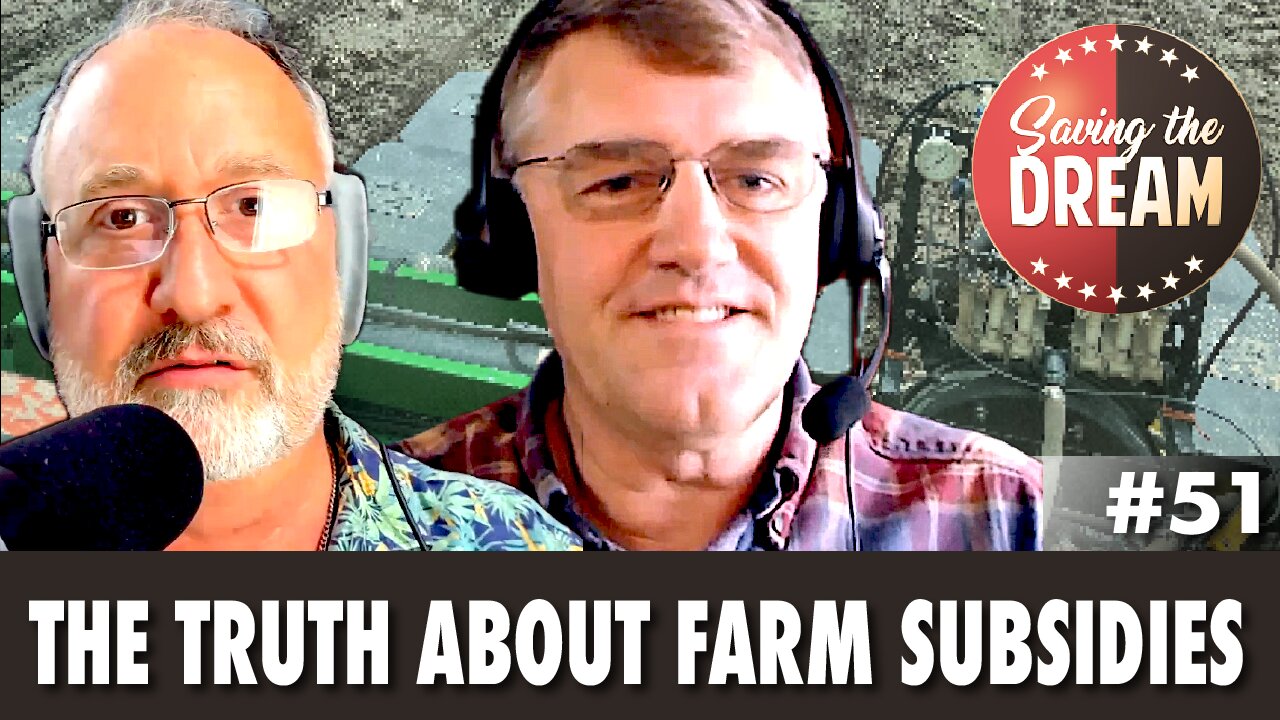Premium Only Content

The Truth About Farm Subsidies (from a real farmer) | Saving the Dream #53
Following our federal budget debate in Episode 47—Paul Anderson (fourth generation farmer from Nebraska) sets us straight on how farm subsidies actually work. Forget what you've heard. It's even weirder.
-
This video features a discussion on farm subsidies from the perspective of a fourth-generation farmer from Nebraska. The conversation covers the history, evolution, and impact of farm subsidies, as well as personal anecdotes and insights into farming practices, government policies, and the economic implications of subsidies on the agricultural sector.
- Farm subsidies were introduced in the 1930s to address oversupply and economic downturns, evolving through various policies and farm bills.
- A significant portion of federal spending goes towards agriculture, with farm subsidies amounting to around 30 billion dollars.
- The 1996 farm bill aimed to phase out subsidies, but falling prices in the early 2000s led to a resurgence of subsidies and disaster relief bills.
- Subsidies can distort decision-making and resource allocation, emphasizing the importance of market forces in the agricultural sector.
- There is a steady supply of individuals interested in farming, challenging the notion that farmers are a dwindling population in need of subsidies.
- Farming attracts individuals due to the autonomy of being one's own boss, despite the hard work and low financial returns.
- Government subsidies impact farmers by influencing risk-taking behavior and decision-making, with lobbying efforts by stakeholders like bankers.
- Subsidy programs are complex, with payments calculated based on factors like crop yields and market prices.
- Farm subsidies significantly affect the financial margins of agricultural operations, with variability in payments based on past production and current market prices.
- Most farmers want to eliminate direct payments as they aren't tied to current performance, affecting land prices and profitability.
- Government funding increases land prices, affecting local government funding through property taxes and indirectly funding local services.
- Government support can impact farmers' access to capital differently from banks, potentially enabling less skilled farmers and affecting industry efficiency.
- The free market dynamics drive efficient land use in farming, where skilled farmers can outcompete less skilled ones without government intervention.
- The Conservation Reserve Program promotes wildlife conservation by paying farmers to maintain environmentally sensitive acres in natural habitats.
- Regulations around wetlands and farm subsidies restrict farmers' ability to make environmentally beneficial changes on their land.
- Legal issues surrounding accidental cross-pollination with patented seeds highlight the complexity of seed patent disputes and the need for careful consideration of both sides of the story.
--
SAVING THE DREAM is an unconventional podcast featuring real people talking about life in America. If you're enjoying life in the echo chamber where people don't really listen and think, then this one isn't for you. But if you like honest exchanges about things that affect everyday life, then tune in here for a new episode each week. With Michael O'Sullivan and a varying slice of the Saving the Dream crew.
-
 2:04:09
2:04:09
Nerdrotic
3 hours ago $16.05 earnedNew Peruvian Megalithic Site Discovery w/ Michael Collins | Forbidden Frontier #083
58.6K3 -
 LIVE
LIVE
Fresh and Fit
4 hours agoMyron TRIGGERED Rubi Rose Over This!
6,525 watching -
 LIVE
LIVE
TheSaf3Hav3n
3 hours ago $3.04 earnedCALL OF DUTY: BLACK OPS 6 | A QUIET PLACE: THE ROAD AHEAD | #RumbleTakeOver
944 watching -
 LIVE
LIVE
TheNateVibez
2 hours agoOmni-🤖 - First Rumble Stream.🫡 - VETERAN
1,226 watching -
 LIVE
LIVE
Tundra Gaming Live
7 hours ago $1.92 earnedThe Worlds Okayest War Thunder Stream//FORMER F-16 MAINTAINER//77th FS//#rumblefam
173 watching -
 2:32:19
2:32:19
DemolitionDx
3 hours agoSunday night COD with friends.
29.6K1 -
 2:10:14
2:10:14
vivafrei
13 hours agoEp. 237: More Trump Cabinet Picks! MAHA or Slap in the Face? Canada on Fire! Go Woke Go Broke & MORE
171K214 -
 2:23:21
2:23:21
SOLTEKGG
3 hours ago $2.80 earned🟢 First Day on RUMBLE!
30.2K3 -
 LIVE
LIVE
Vigilant News Network
7 hours agoCOVID-Vaccinated Hit With Grave New Reality | Media Blackout
2,208 watching -
 1:26:31
1:26:31
Josh Pate's College Football Show
6 hours ago $2.20 earnedSEC Disaster Saturday | Major CFP Earthquake Coming | Officiating Is A Disaster | New Studio Debut
21.4K1